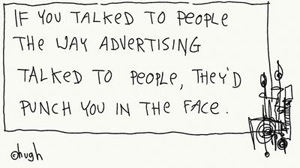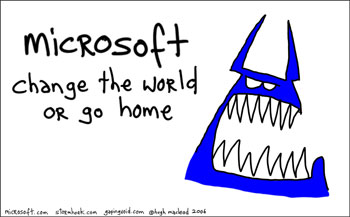With little energy after last night’s massive session of Silent Hunter III, I haven’t written an original essay today. Instead, let me suggest you read two things I’ve commented upon. 1. The redoubtable Laurel Papworth‘s analysis of Corey Delaney’s page being deleted from Wikipedia. 2. Duncan Riley’s polemic on life streaming and whether we should still draw the line on privacy somewhere.
Retreating into the walled garden, for safety
Why do people pour their lives into proprietary environments like Facebook when everything they need to communicate with their friends is already on their desktops? Or their phones. The inimitable Stephen Fry has once again written complete sense, theorising that it’s deep human nature.
What an irony! For what is this much-trumpeted social networking but an escape back into that world of the closed online service of 15 or 20 years ago? Is it part of some deep human instinct that we take an organism as open and wild and free as the internet, and wish then to divide it into citadels, into closed-border republics and independent city states? The systole and diastole of history has us opening and closing like a flower: escaping our fortresses and enclosures into the open fields, and then building hedges, villages and cities in which to imprison ourselves again before repeating the process once more. The internet seems to be following this pattern.
How does this help us predict the Next Big Thing? That’s what everyone wants to know, if only because they want to make heaps of money from it. In 1999 Douglas Adams said: “Computer people are the last to guess what’s coming next. I mean, come on, they’re so astonished by the fact that the year 1999 is going to be followed by the year 2000 that it’s costing us billions to prepare for it.â€
But let the rise of social networking alert you to the possibility that, even in the futuristic world of the net, the next big thing might just be a return to a made-over old thing.
Another possibility, I guess, is that most people are overwhelmed by the choices available. Facebook and the rest just give them a few obvious options and they can get on with it. Or are both Mr Fry and I completely missing it?
2007: Social media goes mainstream (except for business and politics)

If 2006 was the year of Web 2.0 then 2007 is the year of social media. For individuals anyway. Australian businesses and politicians generally don’t get it
Social media is mainstream. Two million Australians have Facebook pages and 3.5 million read blogs. MSN Messenger has 7 million users here, and even Ja’mie King says “I’ll MSN u 2nite” without explanation.
But few businesses use social media. Why? I suspect there’s two reasons, apart from an endemic inability to adapt and change. One is about the tools, the other is about business culture.
Continue reading “2007: Social media goes mainstream (except for business and politics)”Behind the pace
I’ve just finished writing an article for Crikey on how businesses are well behind the pace in using social media. Then I called a new client asking where to email their invoice. “We don’t really have email,” they said. How can a retail business which has to coordinate four shops (plus who knows how many suppliers) possibly operate competitively with last-century technology?
So much for Facebook’s contextual advertising…
So, Facebook now has advertising which is tailored to the user. OK, I’m an attached gay man. What ads do I see?

Back to the drawing board I think, chaps. Unless you think my wedding day should be something really special?
How can Microsoft stop us hating them?
So what do you think of Microsoft, eh? No, really. I want to know.
I have to admit I’m not exactly a fan. I’ll explain why momentarily. But Microsoft is changing, or at least wants to change, and I’m finding it hard to shed old impressions.
The Blue Monster cartoon is part of this changing Microsoft. Its creator, Hugh MacLeod, intended it as a conversation-starter — what he calls a social object. Steve Clayton from Microsoft UK says they use it to help Microsoft start talking about its own process of re-birth.
I’m cynical when software companies claim grand goals like “changing the world”. That over-the-top rhetoric was central to the first dot-com bubble. Usually, the bigger the rhetoric the crappier the product. Still, I’m willing to listen.
Another sign of a changing Microsoft is my friend Nick Hodge, who sold me my first Mac back in 1985. Nick now works for the Blue Monster as an “enthusiast evangelist”, and represents how Microsoft is embracing blogging and a new culture of openness — and actually having conversations with people instead of talking at them.
But can Microsoft really change and, more importantly, convince us to believe them?

